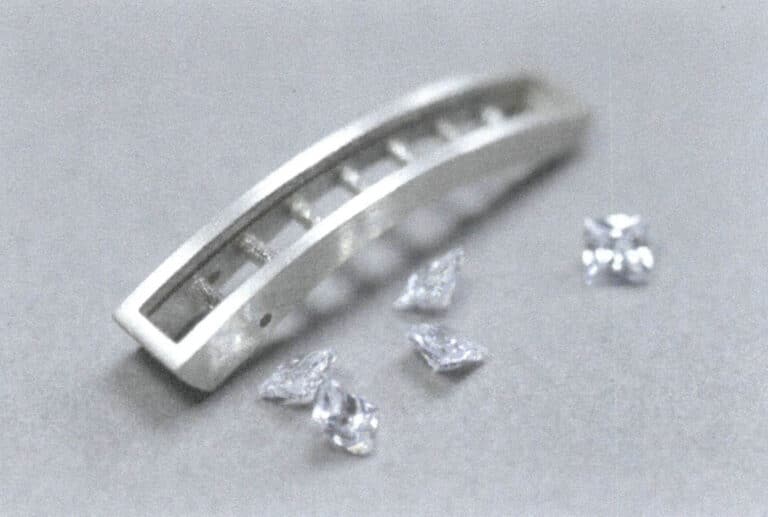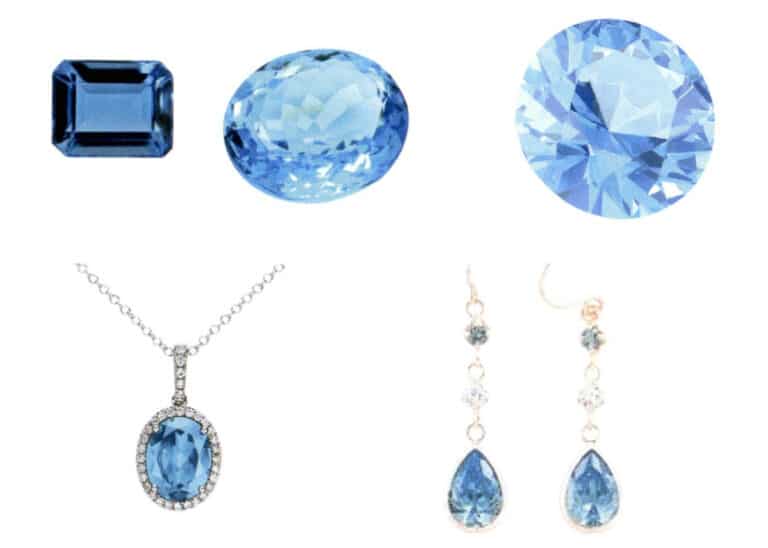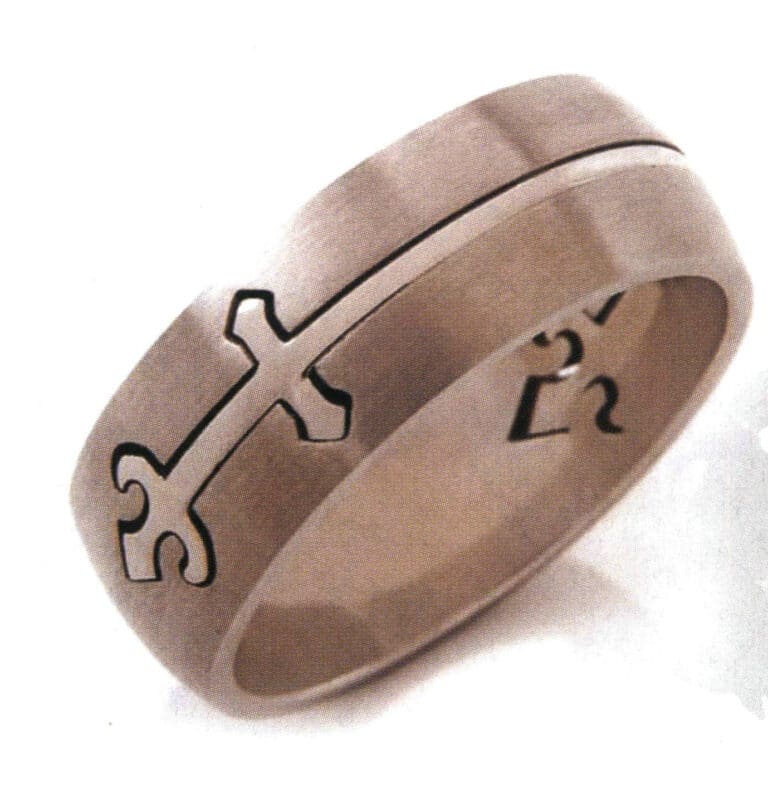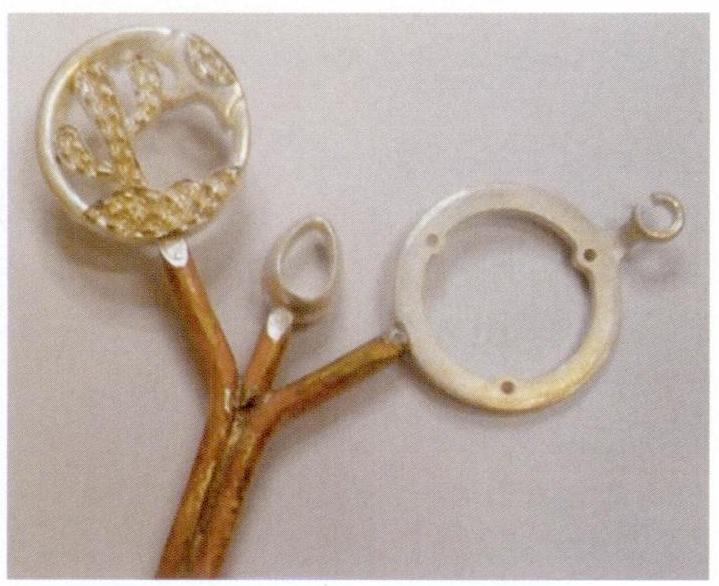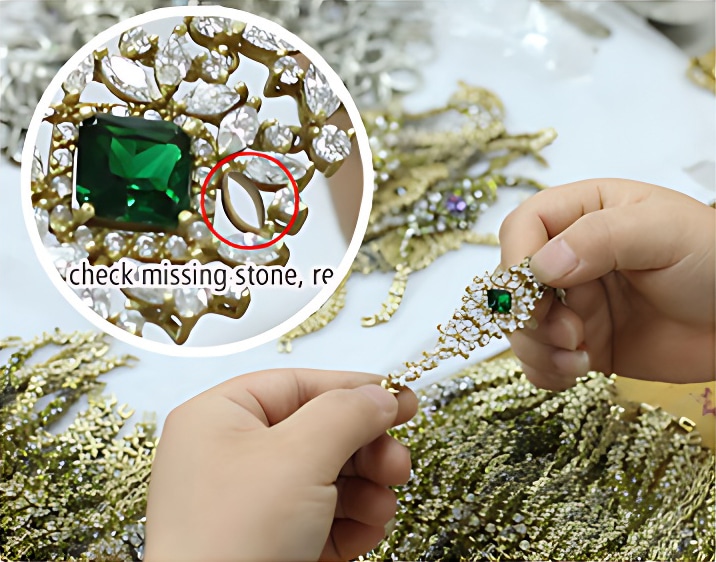Curieux de connaître les origines, les styles et les secrets de fabrication des bijoux ? Découvrez-les ici !
Discover the Origins, Evolution, and Essential Tools & Materials of Jewelry Making
Introduction :
Want to know how jewelry started and how it evolved? Interested in the different types of jewelry and their unique features? Looking for the essential materials and tools needed for jewelry making? This article has got you covered. Whether you’re a jewelry store owner, designer, or an e-commerce seller, you’ll find valuable insights into the world of jewelry.
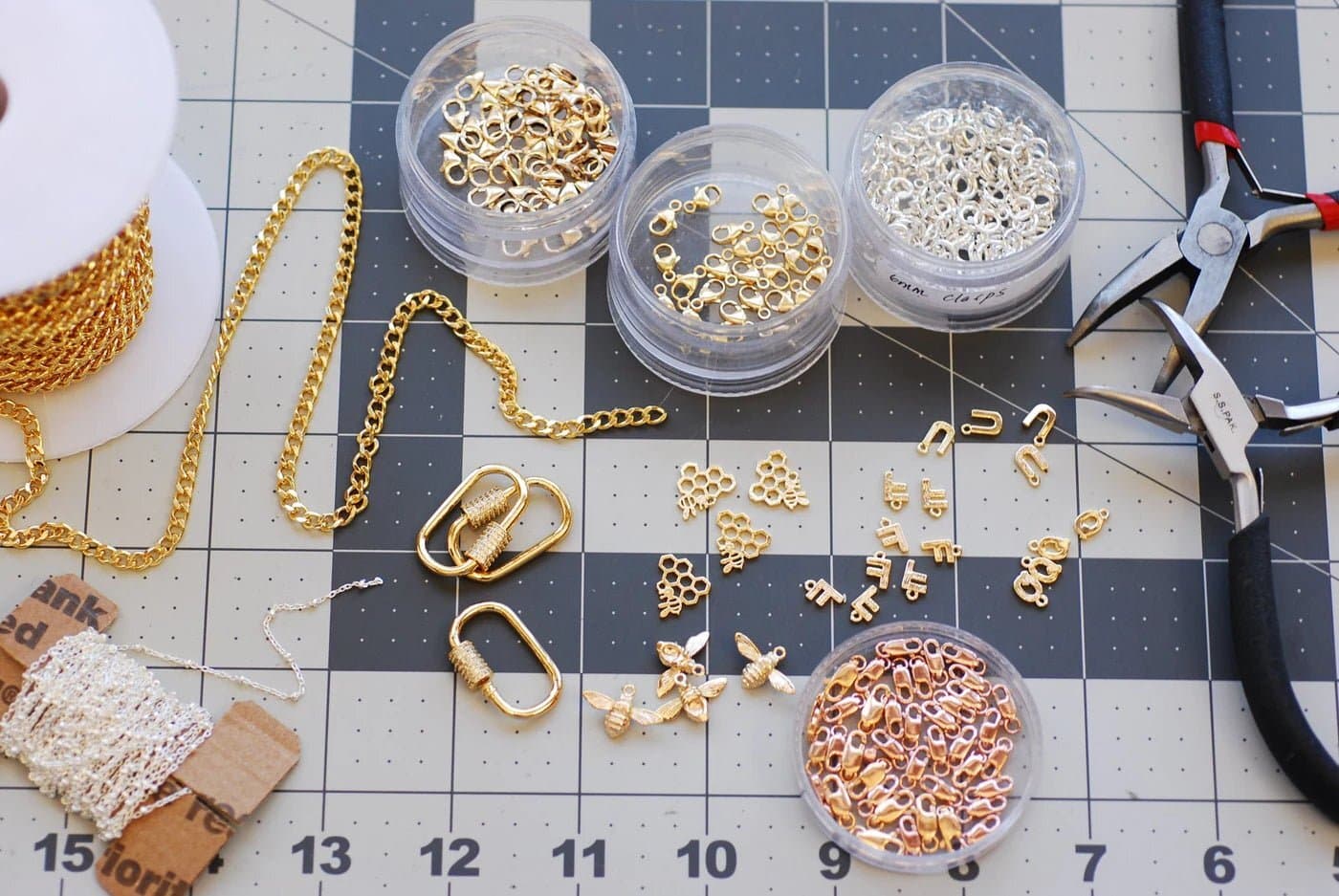
matériel et outils pour la fabrication de bijoux artisanaux
Table des matières
Section I The Origin and Development of Jewelry
1. Definition of Jewelry
2. The Cultural Origins of Jewelry
(1) Originating from the Need for Survival
In primitive society, during the struggle against nature, humans often wore animal skins, horns, and other items on their heads, necks, wrists, or feet to protect themselves from the harm of wild beasts. On the one hand, this was to disguise themselves as prey to confuse their opponents, and on the other hand, these animal skins and horns themselves served as defensive or offensive weapons. To survive and develop, humans needed to constantly fight against wild animals, so wearing items made from the bones and teeth of beasts, as well as beautiful stones from nature, could demonstrate that they were warriors who had conquered wild animals, thus gaining powerful spiritual strength, making them braver, more agile, and stronger in the struggle for survival. In other words, these ornaments were originally worn to represent human wisdom, courage, and strength in labor. Therefore, while primitive people were making and using stone tools, they also slightly polished and drilled animal teeth, bones, and beautiful stones from nature to string them together, which became the earliest jewelry in human history.
As for those small pebbles, animal bones, or beast teeth that hang around the neck, waist, or wrist, their true function, aside from being humans’ earliest unconscious decorative acts, maybe for counting or recording.
(2) As a Symbol of Power and Authority
Brave individuals often like to adorn themselves with bright and eye-catching objects that are easy to recognize, such as light feathers, the teeth of fierce beasts, sparkling shells, and even precious jade. Plekhanov said in “On Art”: “These things were originally worn merely as marks of bravery, agility, and strength.” It is precisely because they are marks of bravery, agility, and strength that they began to evoke aesthetic feelings and fall into the decorations category. Jewelry has become a material for beautifying humanity and a symbol of power, strength, bravery, and wealth.
(3) As a Form of Totem Worship
The sun, moon, stars, wind, rain, thunder, and lightning were originally ordinary natural phenomena; however, to primitive people, these things possessed a certain magical power. Primitive people lived near nature, coexisting with the sun, moon, stars, rivers, lakes, seas, birds, and beasts, and they greatly revered these gifts of nature that sustained their existence. Over time, these items became deeply ingrained in their minds, evolving into totems with magical powers. People regarded these items as their ancestors or protective deities or viewed them as blood relatives of their clan or tribe, worshipping them accordingly. Initially, humans sought to assimilate themselves with these totems to gain protection, such as by wearing the skins or other parts of totem animals, braiding their hair, or decorating their bodies. Gradually, people integrated these totems into their jewelry.
(4) As a Talisman to Ward off Evil and Seek Peace
Primitive people believed that everything has a soul and that benevolent spirits bring happiness and joy to humans, while malevolent spirits bring disaster and disease. To keep those malevolent spirits at bay and to receive protection from benevolent spirits, primitive people wore items such as shells, small pebbles, feathers, animal teeth, leaves, and fruits tied with ropes. They believed these items possessed a supernatural power that could provide protection and drive away evil. These protective and exorcising items became specific ornaments worn on the body, becoming specialized jewelry. Moreover, this custom and its significance have been preserved, and jewelry has been imbued with more beautiful meanings and mysterious connotations by humans.
(5) As the Aesthetic Need of the Ornament itself
Grosz said in “The Origin of Art”: “The love of decoration is humanity’s earliest and strongest desire.” The reason primitive people adorned themselves with beautiful feathers, shiny shells, and precious stones was largely to enhance their charm. At the same time, as humans evolved, their sense of smell gradually diminished, and their sense of sight became sharper, leading to increasing sensitivity to images, colors, and light and a heightened aesthetic sense. Therefore, the emergence of jewelry is a response to this aesthetic need. As a primary means of body decoration, it has persisted through countless generations and evolved alongside human development.
3. The Development and Changes of Jewelry

4. The Significance of Beading and Knotting
Generally speaking, the majority may not necessarily accept fashionable items, and widely circulated items may not be considered fashionable. However, the current beading and knotting have perfectly combined fashion and trend. Do not underestimate these small trinkets; they have gradually become another decorative highlight for those who want to showcase their individuality.
Why do beading and knotting have such great charm? They are just ordinary beads, but when paired with people or used differently, they can always reflect different tastes and styles. More importantly, you can make them yourself, fully showcasing your dexterity and personality, and you can change them however you like. For example, beaded jewelry can be worn at varying lengths on your chest; it can also sway gracefully as an adornment on your earlobes; it can transform into a delicate butterfly flying in your hair; it can be a lovely little flower budding between your fingers; and of course, it can also be a pendant hanging on your phone…
Today is an era that calls for individuality, demanding endless change and absolute difference. Beading and knotting have emerged in response to this overwhelming personality trend, as only they can satisfy this uniqueness and distinctiveness.
Section II Classification and Characteristics of Jewelry
1. Classification of Jewelry
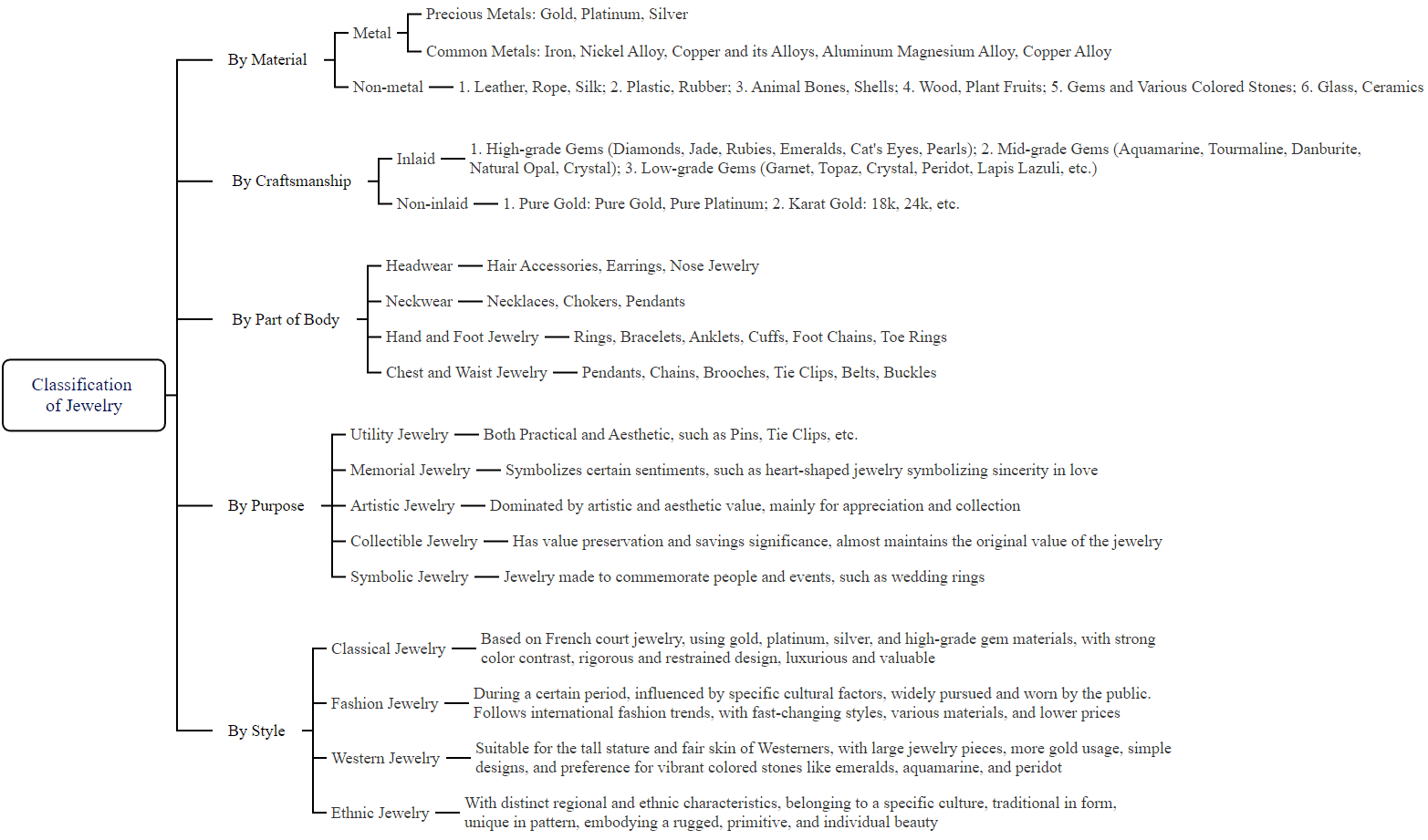
2. Characteristics of Jewelry
2.1 The Design Concept of Jewelry
The design concept of jewelry is the basic idea and design direction that guides jewelry design and creation, encompassing an understanding of jewelry culture, grasping jewelry fashion trends, positioning jewelry styles, and mastering jewelry creation methods.
(1) Design based on Human Needs
The ultimate consumers of jewelry are people, and it needs to meet their material and spiritual needs on different levels. Modern jewelry design not only has to satisfy the mass production of the commodity market but also needs to incorporate the preferences of different individuals to create better, more personalized, and human-centered works. Therefore, modern jewelry design combines art, technology, and humanity.
(2) With Decorative Beauty as the Soul
Jewelry is an ornament that decorates people and their environment. In the design process, on the one hand, it is necessary to highlight the decorative function and aesthetic effect of the jewelry; on the other hand, the jewelry itself, as a product, also needs to have beautiful elements or patterns for thematic decoration, achieving a perfect combination of the jewelry’s material and design theme.
(3) With Creativity as the Source
Innovation and improvement are specific design methods, while change is the essence of design. Creating personalized products that meet consumer needs is the primary task of creativity, which requires breaking traditional concepts, exploring new materials for jewelry, and guiding the personalized development of the jewelry market.
(4) Rooted in Culture
Jewelry is both a product and a cultural carrier. In jewelry design, it is important to skillfully explore traditional culture, regional culture, folk culture, festival culture, and various human historical phenomena and to showcase and express the inherent cultural attributes and unique charm through the jewelry’s specific forms, symbols, patterns, and designs.
2.2 The Shape Characteristics of Jewelry
The design elements of modern jewelry include points, lines, surfaces, and bodies (space), characterized by novelty in design and diversity in materials.
(1) Point
A point is the smallest constituent element in forming shapes, serving as the basic unit of the components that make up a form. In jewelry design, each gem or pearl can be seen as a “point” shape, each carrying different meanings. When arranged and combined in jewelry, what appears to be a monotonous point takes on various forms and is simple yet beautiful, organized yet lively and concise. The outline of a point is relative; its shape often embodies human emotions.
(2) Line
Lines have rich expressiveness and are frequently used in modern jewelry design. Lines can vary in length, thickness, rigidity, flexibility, and waviness; straight lines can extend in all directions, conveying a sense of decisiveness and firmness. The undulating changes of curves can give a gentle and smooth feeling, while circular lines can express a sense of completeness and unity. The popularity of geometric jewelry fully demonstrates the charm of lines in jewelry design.
(3) Surface
The expression of a surface is always accompanied by changes in points and lines, giving a basic psychological impression of smoothness and stability. Geometric surfaces formed by geometric curves convey a sense of simplicity, clarity, and brightness but also carry a mechanical and cold feeling. For example, a circular surface gives a sense of unity, stability, and harmony; an oval surface conveys a feeling of softness, liveliness, and a sense of self-movement within stillness; square and rectangular surfaces, as well as diamond-shaped surfaces derived from squares, all evoke a psychological feeling of being solid, stable, and serious.
(4) Body
The organic combination of points, lines, and surfaces forms a body (space), and the body’s composition is the soul of jewelry design. In conception and design, the body is the fundamental element that makes the jewelry shape vivid. Modern jewelry design begins with the conception of infinite space, then forms a limited psychological space for the jewelry, and finally can design a correct, reasonable, and profoundly meaningful practical space for the three-dimensional shape of the jewelry.
2.3 Characteristics of Jewelry Style
The design styles of modern jewelry are difficult to define, as the diversification and frequent changes in modern social culture often lead to jewelry design that integrates several styles and techniques. These styles can be categorized into neoclassical jewelry, natural style jewelry, conceptual jewelry, postmodern jewelry, and so on.
(1) Neoclassical Jewelry
It mainly refers to the absorption of traditional styles from China and abroad in terms of shape and the variant reconstruction of classical symbols, patterns, and designs. Humanity can never forget its civilization. The retro trend almost resurfaces every few years and becomes increasingly intense. Its characteristics emphasize the careful design of jewelry’s colors, patterns, and contours, with brilliant and gorgeous colors and complex and exquisite structures.
(2) Natural Style Jewelry
The design aims to achieve a primitive meaning, allowing the wearer to feel a return to simplicity and a connection to nature. It conveys a sense of tranquility, peace, and innocence through proportionate shapes, expressing a harmonious spiritual beauty.
(3) Conceptual Jewelry
Generally, it refers to jewelry that expresses a certain concept or imagery of the designer. Its characteristics include a pursuit of individuality and an emphasis on meaning. The work’s pursuit of thought, imagery, and meaning far exceeds the innovation of form, such as the bizarre combinations of modern materials with traditional materials, the pairing of expensive and inexpensive elements, and the strong contrast created by black and white.
(4) Postmodern Jewelry
A group of postmodern designers advocates for satisfying people’s spiritual aesthetic and nostalgic needs through more forms of beauty. Jewelry design features a retro; retro is not a copy of ancient works but absorbs certain design fragments and elements with modern technology and materials. Secondly, it emphasizes “cultural context,” focusing on inheriting local characteristics and historical cultural traditions. Thirdly, emphasize decoration, highlighting that “more is also beautiful,” and emphasize the exquisite details.
2.4 Characteristics of Jewelry Materials
2.5 The Color Characteristics of Modern Jewelry
Section III Materials and Tools
1. Basic Tools
(1) Pliers (Figure 1-3)
- Diagonal cutting pliers: also known as wire cutters, used to cut through some thinner metal wires or needles of inappropriate length;
- Round-nose pliers: also known as looping pliers, used to create beautiful circles, generally used for bending 9-gauge pins, T-pins, etc.;
- Flat-nose pliers: can be used to clamp flat positioning beads, straighten bent wire or needles, open and merge single loops, etc.;
- Wire looping pliers: one end is round-shaped, and the other is groove-shaped, used to bend beautiful circles.
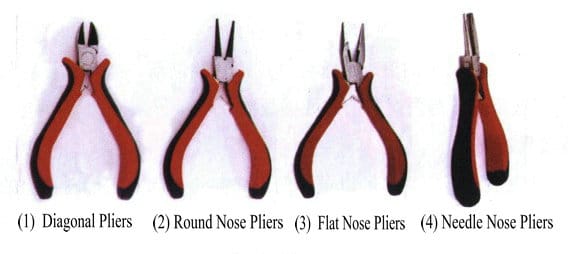
(2) Other Tools (Figure 1-4)
- Tweezers: used to hold small accessories for sticking rhinestones or small items.
- Scissors: used for cutting threads and ropes, etc.
- Hot melt glue gun and hot melt adhesive: The hot melt gun is used with hot melt adhesive, suitable for bonding fabrics, ear pins, etc. The glue stick can be heated directly with fire, but it will cause the glue to turn black, affecting the production effect, so using it with a hot melt gun yields better results.
- Beading needle: Used for stringing beads. Some threads are too soft, making it difficult to string beads directly, or the beads are too small, a needle is required for stringing.
- Ring adjuster: used for opening and closing a single loop.
- Storage box, storage container: can store loose bead accessories, etc., to avoid small items being difficult to keep.

2. Basic Accessories
(1) Wire
① Fishing line: transparent, not easy to break, but special attention is needed when tying knots, as the surface of the fishing line is smooth, and if the knot is not tied well, it can easily come loose. A fishing line is mainly used for patterned beading, generally selecting a thickness of 0.2~0.4mm, and for making large vases, a thicker 0.6 mm fishing line should be used for tissue boxes (see Figure 1-5).
② Round elastic line: transparent and round, similar to fishing line, but with more elasticity; the elasticity is quite average, suitable for threading ordinary round bracelets; when tying the knot, it is necessary to tie a tight knot, it is recommended to add a drop of liquid glue to prevent the line from slipping open.
③ Silk-like elastic line: available in various colors, flat in shape, composed of multiple fine threads combined into one line, commonly used for threading natural crystal bracelets, can be matched with beads of different colors; under frequent friction with beads, it is prone to break over time, especially when stringing crystals and glass types, requiring regular replacement.

④ Waxed cord, beading thread: Mainly used for stringing necklaces and bracelets, this type of line is not commonly used in crystal bead stringing and is most suitable for making bead jewelry that requires a strong drape effect, which cannot be achieved with other materials. The waxed cord is first carefully woven from fiber monofilament into a semi-finished product and then processed through high-temperature environmentally friendly waxing equipment. Its characteristics include high breaking strength, strong abrasion resistance, and no elasticity. Cotton, silk, polyester-cotton, and polyester lines treated with waxing equipment are called waxed cords. Beading thread is a type of material used for knotting Chinese knots, with high-density jade lines divided into A beading thread (diameter 1 mm), B beading thread (diameter 1.5 mm), C beading thread (diameter 2 mm); No. 72 line is the thinnest among beading threads (diameter 0.8 mm); there are also thicker threads for knotting bracelets: No. 2 thread (diameter 4 mm), No. 3 thread (diameter 3.5 mm), No. 4 thread (diameter 3 mm), No. 5 thread (diameter 2.5 mm), No. 6 thread (diameter 2 mm), No. 7 thread (diameter 1.8 mm), which can be worn together with jade pieces, see Figure 1-6.
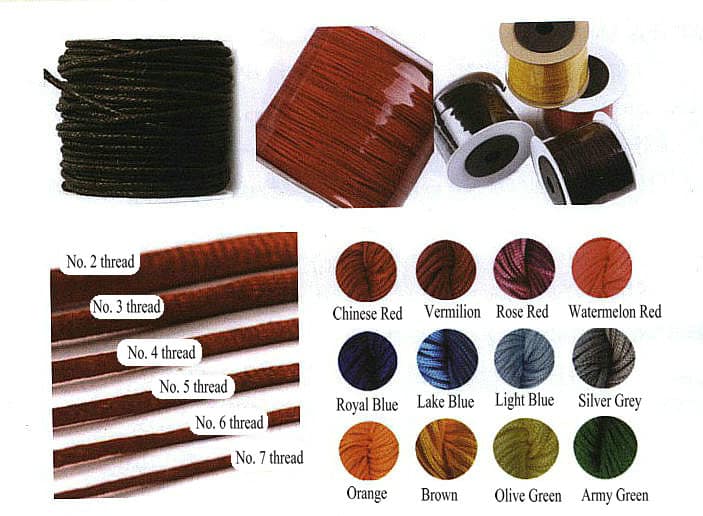
⑤ Copper wire: It is relatively soft and suitable for shaping or fixing. The thickness of copper wire varies with different specifications, resulting in different effects. However, do not twist it too tightly when using copper wire, as it may break easily. See Figure 1-7 (1).
⑥ Steel wire: It is relatively hard and is generally used to make bracelet rings, collars, etc., and can also be used to create floral shapes. However, it cannot be used to wrap things like copper wire and has significant limitations when used for floral shapes. Without creases, it will automatically return to its original shape and cannot be woven, see Figure 1-7 (2).
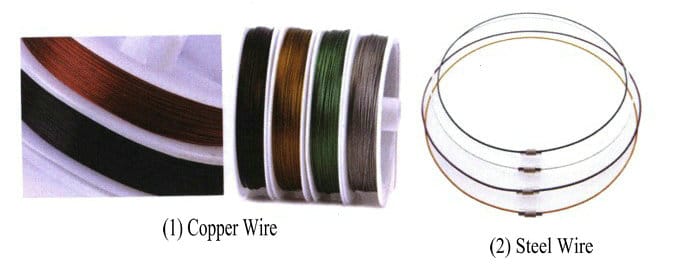
Copywrite @ Sobling.Jewelry - Fabricant de bijoux sur mesure, usine de bijoux OEM et ODM
(2) Metal Accessories (Figure 1-8)
① Jump ring: also known as O-shaped ring or C-shaped ring, serves as a connector between two accessories, available in various models, and 4mm and 6mm are commonly used.
② Head pin: It is T-shaped, with one end being needle-like and the other end flat. It comes in various specifications, with a common length of 2cm, 2.6cm, 3.5cm, 4.4cm and a thickness of 0.7 mm. After threading the beads onto the head pin, hang it at the bottom of the jewelry.
③ Eye pin: It is in the shape of a 9, with one end being needle-like and the other ring-shaped. It comes in various specifications, with a common length of 2cm, 2.6cm, 3.5cm, 4.4cm and a thickness of 0.7 mm. Generally, after threading beads or other accessories in the middle, the other end is also bent into a ring shape, connecting other accessories above and below.
④ Bead tip: also known as a core end or clamshell bead tip, serves a connecting role in accessories, generally used at the beginning and end of a complete piece of jewelry, often used in conjunction with a fishing line and bead tip.
⑤ Positioning bead: also known as stopper beads and positioning tubes, used after being flattened, serve a fixing function, are commonly used inside crimp beads, and are essential accessories for making bracelets, necklaces, etc. They can also be used externally, such as for tassels, to secure beads in a designated position.
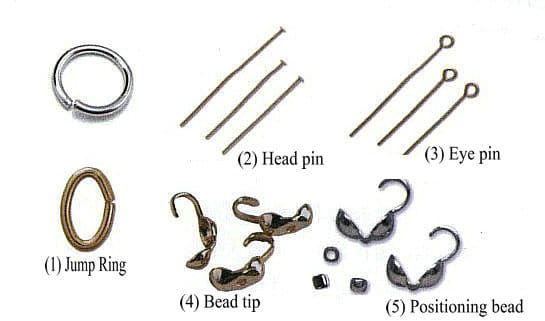
(3) Specific Accessories
① Ear hooks: Essential for earrings, available in various styles, ear studs, hoops, etc., see Figure 1-9.

② Ear clips: suitable for those without pierced ears, divided into plastic ear clips, ordinary iron ear clips, pure copper ear clips, screw ear clips, and the most popular at present is the invisible spring earrings, which are comfortable to wear and have the effect of pierced earrings, see Figure 1-10.
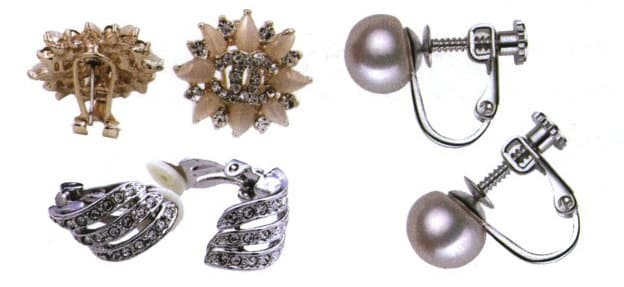
③ Hair stick: Essential for making hair accessories, see Figure 1-11 (1).
④ Brooch fastener: When making brooches, it is recommended to use hot melt adhesive; see Figure 1-11(2).
⑤ Ring mount: The mount is needed to make a ring. There are various styles of ring bases, which can be chosen according to personal preference and the usage of other accessories; see Figure 1-11 (3).

⑥ Metal chain: used for making necklaces, bracelets, tassels, etc. Generally, hole chains can be directly used with a jump ring, and eye pins or T-pins can be used to shape the chain for hanging some beads, small accessories, etc. Hole-less chains need to be used with other matching accessories (such as bead chains and ball chains need to be used with shell clasps, while metal chains need to be used with wire buckles, clips, or crimp bead); see Figure 1-12 (1).
⑦ Adjustable chain: also known as extension chain, used at the end of the chain to adjust the length of the chain. It is recommended to use a lobster clasp or spring clasp; see Figure 1-12 (2).
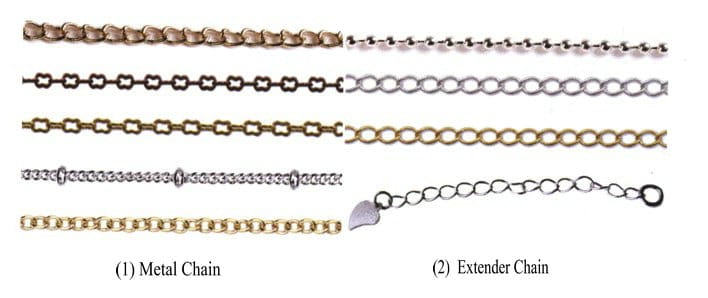
⑧ Clasp: commonly used in the connection parts of necklaces and bracelets, divided into ordinary and decorative clasps.
- Lobster clasp: as small as 1.2cm×0.7cm, as large as 2.8cm×1.8cm, see Figure 1-13.
- Magnetic clasp: Uses the magnetic force of magnets to attract its ends together; see Figure 1-14.
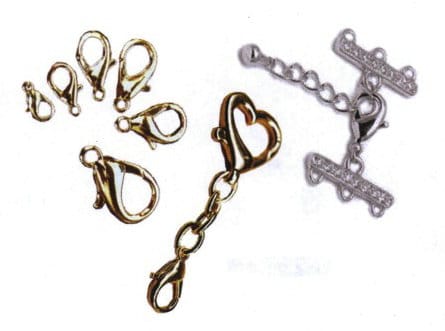
Figure 1-13 Lobster Clasp
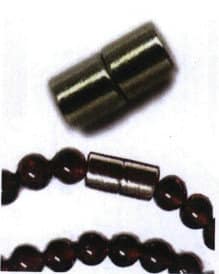
Figure 1-14 Magnetic clasp
- Twist clasp: Functions similarly to a screw, twisted together, with various appearances; see Figure 1-15.
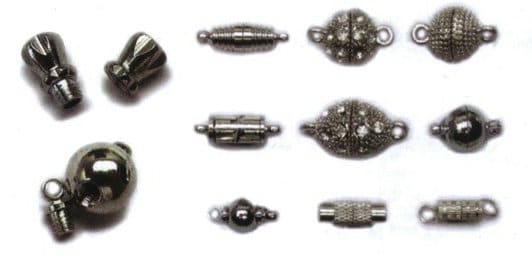
- Pendant clasp: The pendant has shapes such as pure copper inlaid with diamonds, with exquisite craftsmanship and novelty, serving a dual purpose of decoration and function, specifically designed for the ends of various bracelet cords and necklace cords, convenient and easy to use, see Figure 1-16.
- Snap clasp: also known as a press stud, made of alloy, silver-plated, gold-plated, available in matte and shiny surfaces, commonly used at the junction of necklaces, see Figure 1-17.

Figure 1-16 Pendant clasp
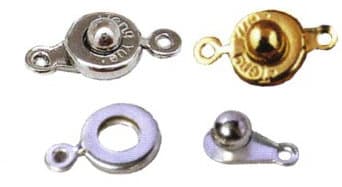
Figure 1-17 Snap clasp
- M-shaped clasp: The shape of the chain clasp is like an M, a classic chain clasp. There are also S-shaped, U-shaped, lobster-shaped, and other shapes, generally around in size of 10mm×9.5mm. It can also have decorations like bells and be electroplated with platinum, gold, rose gold, Tibetan silver, and Thai silver, see Figure 1-18.
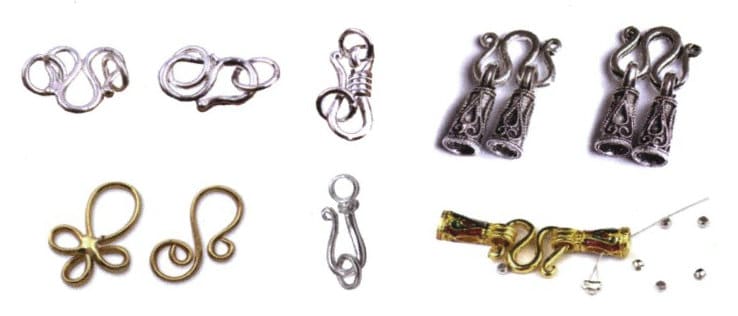
- Spring clasp: A spring is set inside the ring, opening and closing. Generally available in colors such as gold, silver, K white gold, and bright steel (stainless steel), with sizes typically around 4.5~9mm, see Figure 1-19.
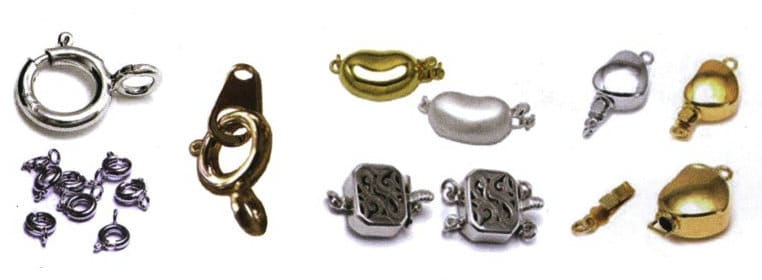
- OT clasp: one side is ring-shaped, and the other is rod-shaped. The OT chain clasp is most suitable for making bracelets or waist chains but not for making necklaces; see Figure 1-20.
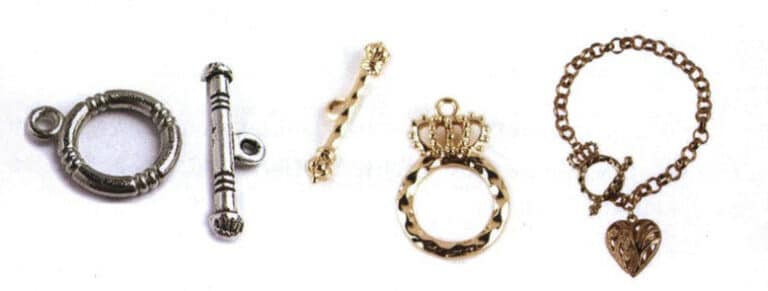
3. Beading Materials
(1) Copper
In simulated jewelry, it belongs to higher-end accessories. Copper accessories have a good luster, a relatively uniform color, a smooth surface, and a nice feel. They are relatively resistant to fading and rust. However, some styles are priced higher.
(2) Iron
In imitation jewelry, a significant portion is occupied by general adjustment chains, which are made of iron. Iron is relatively inferior to copper; the luster and color are both poor, the texture is rough, and it is prone to rust and fading, but the price is low.
(3) Steel
Steel texture is relatively hard, so there are generally no large areas of steel components in imitation jewelry. The commonly used steel components are only steel wires and steel rings (bangle rings, collars, ring bands, etc.), which have high hardness, are not easily deformed, and are relatively prone to fading.
(4) Alloy
The material of the alloy is difficult to describe, and different alloy accessories vary greatly in quality. Before purchasing, you can take a close look or consult the seller about the quality of the actual product. Alloys are moderately priced and have strong plasticity.
(5) Jewelry and Gemstones
Jewelry and gemstones can be divided into three main categories.
- Jade: including marble, white marble, Lantian jade, nephrite, jadeite, Nanyang jade, turquoise, malachite, Shoushan stone, fluorite, etc. The colors and shapes of jade are relatively uniform, and many colors are artificially dyed. Some jades are quite fragile or contain noticeable impurities.
- Organic stones: pearls, coral, amber, ivory, tortoiseshell, jet, shells, etc.
- Gemstones: including diamonds, rubies, sapphires, lolite, zircon, emeralds, opals, Chrysoberyl Cat’s Eye, topaz, spinel, peridot, apatite, tourmaline, garnet, andalusite, crystal, moonstone, beryl, and amethyst.
(6) Acrylic
A material between glass and plastic, with luster and hardness falling in between the two. It can be divided into transparent types, solid colors, and jelly types. Its price is low and comes in various shapes and colors, making it suitable for a wide range of applications, such as making jewelry, ornaments, bags, and pendants. It is relatively lightweight and lacks a sense of weight.
(7) Imitation Pearl
Imitation pearls are also divided into plastic imitation pearls, acrylic imitation pearls, glass imitation pearls, crystal imitation pearls, etc.
- Plastic imitation pearls: made with plastic as the inner core, electroplated with other colors on the outside, inexpensive, with poor luster, lightweight, lacking a sense of weight, easily scratched, giving a relatively low-end impression.
- Acrylic imitation pearls: made with acrylic as the inner core, electroplated with other colors on the outside. They are inexpensive, have decent luster, and come in various shapes and colors, but they lack a sense of weight, are relatively light, not hard enough, and are prone to scratches.
- Glass imitation pearls: made with glass as the inner core, electroplated/painted on the outside, available in various colors, weight similar to real pearls, moderately priced, good luster, but should not come into contact with hard objects, as they can easily get scratched.
- Crystal imitation pearls are made with crystal as the core, electroplated/painted on the outside, available in various colors, with good luster, and the holes on both sides are also treated more carefully, making them relatively expensive.
(8) Glass Beads
There are ordinary glass beads and crystal glass beads.
- Ordinary glass beads: The surface is almost like crystal, but the luster is not as good as crystal, and bubbles are inside.
- Crystal glass beads: A material between crystal and glass, relatively better processed and slightly more expensive.
Glass beads are generally divided into several forms: hand-polished, machine-polished, and semi-hand-polished, among which hand-polished beads are the most exquisite and the most expensive. The worst are machine-polished glass beads with less defined edges and poorly treated cutting surfaces. They are relatively smooth but are moderately priced, have a more ordinary shape, are fragile, and contain bubbles inside, making them less aesthetically pleasing.
(9) Artificial Crystal
Currently, the most famous are Swarovski crystals (good luster, diverse shapes and colors, dazzling, relatively high price, fragile) and Czech crystals (lower price, varying quality, fragile), among which Swarovski is produced in Austria and is also known as Austrian crystal.
(10) Colored Glass
Currently, multicolored colored glass, Italian millefiori glass, and specialty glass are used for decorative purposes. All of these belong to imitation colored glass, which has the advantages of bright colors, relatively high hardness, and a strong classical flavor but is fragile.
(11) Polymer Clay Flowers
Made of colored clay. The shapes are quite variable, the colors are rich, the plasticity is strong, and the uses are extensive. The craftsmanship is exquisite and beautifully referred to as “cream flower,” but it is prone to dirt and cracking and can be cleaned with laundry detergent.
(12) Cloisonné
Using red copper as the base, various patterns are glued onto the copper base with copper wire; then, colors are filled in the small grids formed by the copper wire. After refining, welding, and polishing, the final product is a brightly colored handicraft that is very classical in style and rich in ethnic characteristics.
Copywrite @ Sobling.Jewelry - Fabricant de bijoux sur mesure, usine de bijoux OEM et ODM





